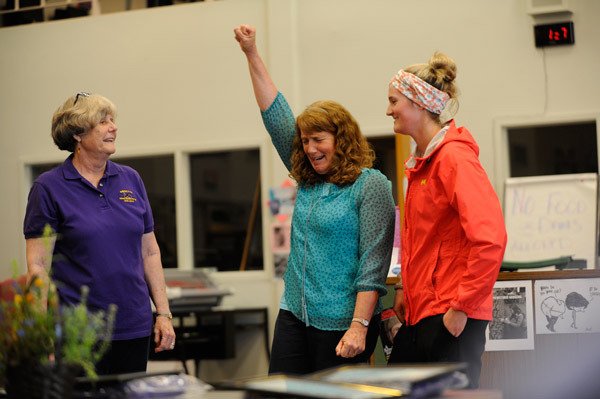“Some people see working with children — the real young ones — and think, ‘That must be draining.’”
Terilee Allsop-Howat grins.
“I look at their energy, their enthusiasm, their joy. I choose to be energized by them.
And it works.”
For someone who’s spent more than four decades helping youths from the high school ages on down, the past 23 years with the Sequim School District as a speech and language pathologist, this summer marks a crossroads for Allsop-Howat.
In June, the longtime educator joined 11 other Sequim School District staffers in calling it a career.
“I’m not sure what I want to do after graduating,” she says. “I have to be a contributor. I have some ideas about volunteering, helping young moms, (but) I look forward to having a flexible work schedule, no paperwork.”
Instead of punching the clock at various Sequim schools and volunteering, Allsop-Howat will be lending a hand with husband Dave at the family owned Dungeness Meadow Farm (which grows organic blueberries) and more time with her daughters — BrookeAnn, a language arts teacher at Port Angeles High School, and Janel, a patient access specialist for Olympic Medical Center.
“I’m just looking for what God has for me next,” she says.
Speaking of Sequim
Growing up in the I-5 corridor near Seattle and Tacoma, Allsop-Howat says she always enjoyed being around children, earning money as a babysitter.
But it wasn’t until she reached her second or third year in college when she struck on an idea that would become her life’s work. While an undergraduate at the University of Washington, she became interested in her roommates’ field of study in speech pathology.
“I’d never heard of it,” she says.
In an introductory class, she says, a professor asked students to imagine this: Your hair is in curlers, you have no makeup on, you’re in crummy slippers. Now, you have to go out in public.
“That’s how people with speech disorders feel every day,” Allsop-Howat says.
After earning undergraduate and graduate degrees at UW, she started her career with a nine-year stint in Federal Way as a speech pathologist, reading specialist and at Head Start.
She worked for a decade in the Olympia area in similar roles and then capped that off with more than 20 years working as a speech pathologist at each of Sequim’s schools except Greywolf Elementary, including both Sequim’s middle and high schools, Helen Haller Elementary and Sequim Community School and Head Start.
Anything but basic
While speech pathology starts at the earliest years, the practice is anything but basic, Allsop-Howat says.
“It’s so much more than teaching how to pronounce sounds,” she says.
Working with such disorders can mean anything as low tech as a simple picture exchange where a child is taught to hand an adult a picture indicating what he wants (food, activities, toys, etc.) to high-end technology.
It can mean coming up with creative ways for the hearing impaired or deaf to help them to be able to communicate or it can mean helping students figure out what’s getting lost in tracking a set of directions from start to finish.
“Some children tend to remember the first part of a set of directions but not the last part,” she says.
It can mean taking on youths with stuttering issues or those who struggle with social skills or even with students who have selective mutism — they may talk at home, but can’t seem to communicate well in the classroom.
“It’s such a wonderful career, such variety,” Allsop-Howat says. “(We) strengthen grammar and vocabulary development, writing skills, (and) there needs to be a lot of collaboration with teachers.”
Speech pathology is a wide-ranging field, she says, with some professionals going into public roles and others in private practice, working with young student clients, to stroke victims and those with brain injuries up to 100 years.
“It’s never the same, every day,” she says.
But she does have a preference in whom she teaches: the youngest crowd.
“Early childhood education is the way to go,” Allsop-Howat says. “Birth to (age) 6: I see the most change happening there.”
“It’s so exciting to see a non-verbal 2-, 3-, 4-year old who expresses himself through screaming and hitting, it’s the only way he can become calmer,” Allsop-Howat says, and then see that same youth learn to communicate over the years.
As she looks back on her career, Allsop-Howat says she is seeing a change in how youths arrive at school.
“We’ve seen children come in with fewer skills than 10 years ago, maybe five years ago, at all grade levels, across the district,” Allsop-Howat says. “Some of us (in the district) think that some of that is due to screen time. They are on screens so much more than they were five, 10 years ago.”
That can lead to problems in myriad ways, particularly in how youths relate to one another and adults.
One simple way to combat that? Reading.
“Even up into the later elementary school and middle school years, (reading) is a great way to put inspiring ideas into their minds, overcoming obstacles, to (boost) self-image and confidence,” Allsop-Howat says.



